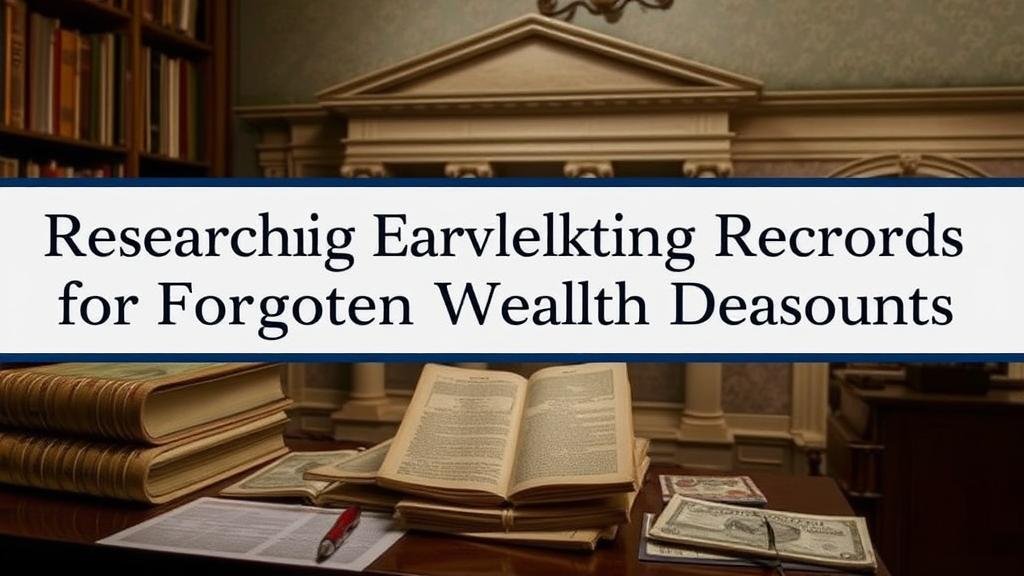Researching Early Banking Records for Clues to Forgotten Wealth Deposits
Researching Early Banking Records for Clues to Forgotten Wealth Deposits
The study of early banking records provides valuable insights into the history of wealth accumulation and distribution. From the rise of banking systems in the 17th and 18th centuries to the establishment of national banks in the 19th century, these records unveil stories of forgotten riches. Exploring historical banking documentation not only sheds light on past economic conditions but can also lead to the discovery of abandoned or forgotten wealth deposits. This research article outlines the methods for accessing these records, the types of information they may contain, and the implications for modern financial and genealogical research.
The Evolution of Banking Records
The evolution of banking records can be traced back to ancient civilizations, where rudimentary forms of financial documentation were maintained. But, the first formal banking records as we understand them began to emerge in Europe during the 17th century. The establishment of banks such as the Bank of Amsterdam in 1609 and the Bank of England in 1694 marked significant milestones in financial history.
As banking systems developed, so too did the methods of record-keeping. Early records often included:
- Deposit slips and withdrawal records
- Account ledgers detailing transactions
- Loan agreements and mortgage documentation
These records were essential for managing finances and often contained information about individuals financial statuses, property ownership, and investments.
Accessing Early Banking Records
Accessing early banking records can be done through several channels:
- National archives and historical societies often hold banking records.
- Major libraries may have special collections related to banking history.
- Online databases and digital archives like Ancestry.com or FamilySearch.org provide access to digitized documents.
For example, the British Library holds an extensive collection of banking records from the 18th century, which can be critical for researchers seeking information on historical financial practices. Those interested in American banking history may want to consult the National Archives, especially for records related to the Bank of the United States and state-chartered banks.
Types of Wealth Information in Banking Records
Banking records can reveal various types of wealth information that may go unnoticed in traditional genealogical or historical research, including:
- Estimation of individual wealth through deposit amounts
- Property assets indicated in loan and mortgage records
- Public bonds and stocks holdings
For example, during the 1830s, many individuals invested in government bonds as a means of wealth preservation. Records from banks during this time may reveal significant holdings that have since been forgotten. information provided in these records can help fill gaps in family histories, uncovering financial legacies that descendants may not have been aware of.
The research into early banking records has real-world implications in both financial and genealogical landscapes. Individuals researching family history may utilize banking documents to claim unrecognized assets or clarify their familys financial journey. Also, financial professionals and historians can benefit from understanding historical wealth distribution patterns, which can influence current economic theories and practices.
Actions to Consider
Those interested in uncovering forgotten wealth deposits may consider the following actions:
- Begin with known family names and connections while utilizing online archival resources.
- Consult regional banking history publications to better understand significant local banks and their records.
- Reach out to historical societies to identify additional resources that might not be available online.
Plus, networking with fellow researchers and utilizing social media platforms can help in sharing insights and resources relevant to early banking records.
Conclusion
Researching early banking records can uncover clues to forgotten wealth deposits and offer a deeper understanding of personal and economic history. e records are not just a collection of numbers; they represent the financial lives of individuals and families. Through diligent research and exploration of historical documentation, individuals may find pathways to unknown wealth and gain insights into their ancestry that can enhance our broader understanding of economic history. As this field of study continues to grow, it holds the promise of revealing even more about our interconnected financial past.



